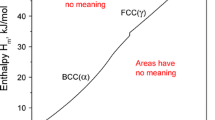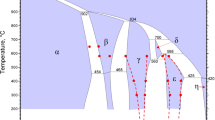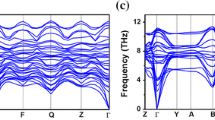Abstract
LLDPE samples synthesized with Ziegler–Natta (ZN) and Metallocene (MT) catalysts have been analyzed to investigate a potential catalyst-dependent morphology and to find an explanation for the difficult processing of MT. Slow calorimetry at v = 0.02 K/min and IR at RT and in the melt are used. The differences between MT and ZN are assigned to their different composition, MT not having the linear segments, which are present in ZN. Slow calorimetry is effectively a drawing process of the melt with chain orientation followed by decay. The later event, characterized by an endotherm, ΔH network, occurs at higher temperatures for MT, the presence of a regular distribution of methyl groups slowing down the process. The rocking, gauche, bending and stretching regions of the IR spectra are analyzed. The nascent MT has more strained bands in the rocking region. The wagging region reveals the more homogeneous environment of MT through the maximum absorbance at 1,368 cm−1. Decomposition of bands is made for the rocking and wagging regions. The orthorhombic crystallinity, αc (FTIR), measures the sum of long- and short-range orthorhombic order, the latter being obtained by αc (FTIR)-αc (X-rays). The values of αc (FTIR) for MT and ZN are very similar in conditions of equilibrium. The justifications for the molecular origin of ΔH network are presented: (i) the slow relaxation of long chains strained and oriented in the melt measured by other techniques, (ii) The correlation, for gels of a linear sample, made in different solvents, between the maximum drawability, λmax, and ΔH network in a slow T-ramp. The range is 80–270 for λmax and 40–120 J/g for ΔH network. (iii) The comparison of two traces of the same sample, between 140 °C and 270 °C, show that comparable events in the melt appear in the integrated absorbance and in the slow calorimetry signal. Analysis on thin films of the little-studied CH2 stretching region reveals that their extinction coefficient, ε, and the shape of the bands are highly sensitive to the sample history, ε diminishing by a large factor in slowly crystallized samples. Events in the slow T-ramp, followed by a fast crystallization, on the other hand, leads to materials with standard characteristics. Slow calorimetry traces display more events (endothermic and exothermic) for MT than for ZN, a finding consistent with more flow irregularities during processing. Equilibrium conditions and better processing could be reached for MT by extending time in the melt or using higher temperatures.











Similar content being viewed by others
References
Kitamaru R, Horii F, Murayama K (1986) Macromolecules 19:636
Kuwabara K, Kaji H, Horii F, Bassett DC, Olley RH (1997) Macromolecules 30:7516
Matter R, Stille W, Strobl G (1993) J Polym Sci Polym Phys Ed 31:99
Delmas G (1993) J Polym Sci Polym Phys Ed 31:2011
Phuong-Nguyen H, Delmas G (1992) Macromolecules 25:408
Phuong-Nguyen H, Delmas G (1992) Macromolecules 25:414
Zhang Z, Lapes I, Phuong-Nguyen H, Delmas G (1997) Can J Chem 75:1354
Phuong-Nguyen H, Delmas G (1995) Collect Czech Chem Commun 60:1905
Phuong-Nguyen H, Charlet G, Delmas G (1996) J Thermal Anal 46:809
Phuong-Nguyen H, Delmas G (1994) J Solution Chem 23:249
Phuong-Nguyen H, Delmas G (1994) J Mater Sci 29:3612
Le Lay P, Zhang X, Delmas G (1998) Carbohyd polym 37:49
Bernazzani P, Chapados C, Delmas G (2000) J Polym Sci Polym Phys Ed 38:1662
Bernazzani P, Bich VT, Phuong-Nguyen H, Haine A, Chapados C, Dao LH, Delmas G (1998) Can J Chem 76:1674
Bernazzani P (1995) MSc. Thesis, University of Quebec in Montreal
Haine A (1995) MSc thesis, Uqam, 1995 and not published work
Bernazzani P, Chapados C, Delmas G (2000) Biopolymers 58:305
Wunderlich B (1980) In: Macromolecular physics, vol 3. Academic press, London, p 12
Boyer RF, Miller RL (1987) In: Keinath SEM, Miller RL, Rieke JK (eds) Order in the amorphous state of polymers. Plenum Press, New York, p 135 and p 33
Brenner T, Rudin A (1992) J Polym Sci Polym Phys Ed 30:1247
Morin FG, Delmas G, Gilson D (1995) Macromolecules 28:3248
van Prooyen M, Brenner T and Rudin A (1992) report to the Institute for Polymer Research, University of Waterloo
Krugel JK (1979) Solid State Commun 30:43
Hussein A, Williams MC (2000) Macromolecules 33:520
Bent J, Hutchings LR, Richards RW, Gough T, Spares R, Coates PD, Grillo I, Harlen OG, Read DJ, Graham RS, Likhtman AE, Groves DJ, Nicholson TM, McLeish TCB (2003) Sci: Int Edn – AAAS. v.301 , n.5640, p 1691, 5 p
Janimak JJ, Stevens GC (2001) J Mater Sci 36:1879
Wignall GD, Alamo RG, Ritchson EJ, Mandelkern L, Schwahn D (2001) Macromolecules 34:8160
Guichon O, Séguéla R, David L, Vigier GJ (2003) J Polym Sci Polym Phys Ed 41:327
Marigo A, Zannetti R, Milani F (1997) Eur Polym J 33:595
Jedidi I, Ferhat-Hamida Z, Delmas G (2007) J Polym Sci Polym Phys Ed 44:in revision
Barbalata A, Bohossian T, Prochaszka K, Delmas G (1988) Macromolecules 21:3286
Wedgewood AR, Seferis JC (1983) In: Seferis JC, Theocaris PS (eds) IUPAC publication
Agosti E, Zerbi G, Ward I (1993) Polymer 34:4219
Zerbi G, Gallino G, Del Fanti N, Baini L (1989) Polymer 30:2324
Painter PC, Havens J, Hart WW, Koenig JL (1977) J Polym Sci Polym Phys Ed 1237
Phuong-Nguyen H, Delmas G (1994) Thermochimica Acta 238:257
Pennings AJ, Smook S (1984) J Mater Sci 19:3443
Acknowledgements
The authors acknowledge the financial support of the NSERC (General grant) and also of a support from Estac (Environmental Science and Technology Agency of Canada). The Bayer company (Sarnia, Ont.) who supported the Estac project gave graciously the samples of LLDPE.
Author information
Authors and Affiliations
Corresponding author
Appendices
Appendix 1: Analysis by slow calorimetry
Our investigation of polymers melting using slow calorimetry has its origin in the study of UHMWPE gels [6]. The heat of dissolution, ΔH diss, at v = 0.0167 K/min measured by integration up to the end of the main peak was found to vary with the solvent .It was for instance 265 J/g in trichlorobenzene (TCB) and 200 J/g in decalin. Melting without solvent in the same conditions gave ΔH melting = 200 J/g. When the T-ramp was continued above T m/T d, a high-T endotherm, ΔH network, was revealed which added a complement to the main peak. Our interpretation was the following: the entangled/network fraction of the material contains some short-range order, the melting/dissolution of which is displaced at higher T because of the strain generated by the T-ramp itself. Strain, as does pressure, shifts T m towards higher temperatures or renders the order unmeltable in the conditions of the experiment. A slow T-ramp leaves time for the chains to respond in an equilibrium situation to the inescapable expansion. The kinetics of melting/dissolution is slow because strain continues to grow in the ramp. In the linear sample, integration was not pursued above 170 °C. The effect of the solvent on ΔH diss is interpreted partly in terms of thermodymanics [11]. Analysis of a variety of polyolefins [7–11] and of amylose (mixed with water) [12, 13, 17] confirmed the generality of the effect of strain on dissolution and melting. This research lead to the understanding of the effect of strain-building on phase-change or other properties [4] and explained ambiguous results reported in the literature.
The present modified model can explain also the events observed on UHMWPE which are seen to involve also two steps .The first step is chain extension (strain-growing) and the second orientation decay (disordering of short-range order). One difference between the two descriptions covers the two steps and is somewhat more than linguistic: chain extension englobes all the chains not only the entangled chains of the network. The other difference is that an exotherm accompanies dissolution and melting and a tracer of chain extension. It has been observed as a sharp peak on gels but not in solids .The exotherm of extension/orientation has a slow kinetics with an enthalpy which overlaps ΔH ortho and ΔH diss and reduces them. In a polydispersed sample, exotherms and endotherms are likely to overlap. Orientation during the ramp depends on the conditions such as solvent-dependant swelling for the dissolution ramp and on the branch content for the melting ramp. The advantage of decay of chain orientation over melting strained order is that its magnitude has no obvious limit so that it can cover the large values of ΔH network. found with MT and ZN and with DSC in non-standard conditions [30].
Appendix 2: IR spectra of PE
The assignment of trans- and gauche conformations in the methylene chain has permitted to identify the ordered and less ordered regions of PE. Most of the analyses rest on a two-phase description of a semi-crystalline polymer. However, other bands are seen in the spectra of films submitted to mechanical deformation, which have been assigned to specific bands to deformed crystals. In highly deformed crystals these bands are observed visually on the spectra (Fig. 4), in less deformed films they are seen as a shoulder or by decomposing the main peak (Figs 1). Decomposition of the bands leads to a quantitative measurement of the orthorhombic, amorphous and strained fractions at RT. The strained fraction is associated with monoclinic crystals and the network phase. The monoclinic IR bands can be seen even when the size of the monoclinic crystals is too small to give the X-ray pattern characteristic of the monoclinic modification. For this reason this fraction has been called monoclinic-like.
The IR spectra of the chains ordered in the orthorhombic and monoclinic modifications present a useful difference: in the orthorhombic modification, a very characteristic doublet in the rocking and bending regions is observed while a singulet appears in the monoclinic modification. The doublet is due to the interaction of the chain in the centre of the cell with those on the sides. This interaction leads to a feature called field-splitting, i.e., to the presence of two bands for the same vibration. This effect does not take place in the amorphous regions or in the monoclinic modification because the chains are further apart. On a series of spectra taken between RT and the melting point T m, expansion of the chains leads to a gradual increase of the amorphous phase and 5–7 K below T m the doublet disappears [15]. Thanks to field-splitting, the fraction of the orthorhombic modification is measurable without ambiguity in the –CH2–CH2– bending or rocking regions of the PE spectra.
Rights and permissions
About this article
Cite this article
Ferhat-Hamida, Z., Phuong-Nguyen, H., Bernazzani, P. et al. LLDPE’s grown with Metallocene and Ziegler–Natta catalysts: events in the melt and FTIR analysis. J Mater Sci 42, 3138–3154 (2007). https://doi.org/10.1007/s10853-006-1434-4
Received:
Accepted:
Published:
Issue Date:
DOI: https://doi.org/10.1007/s10853-006-1434-4




